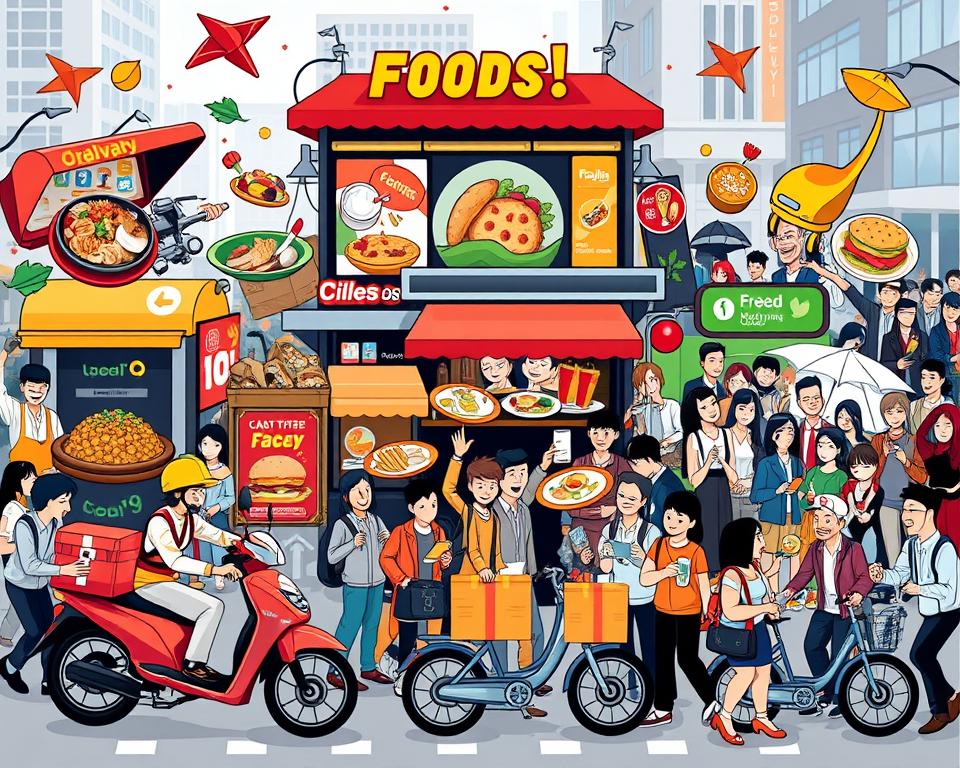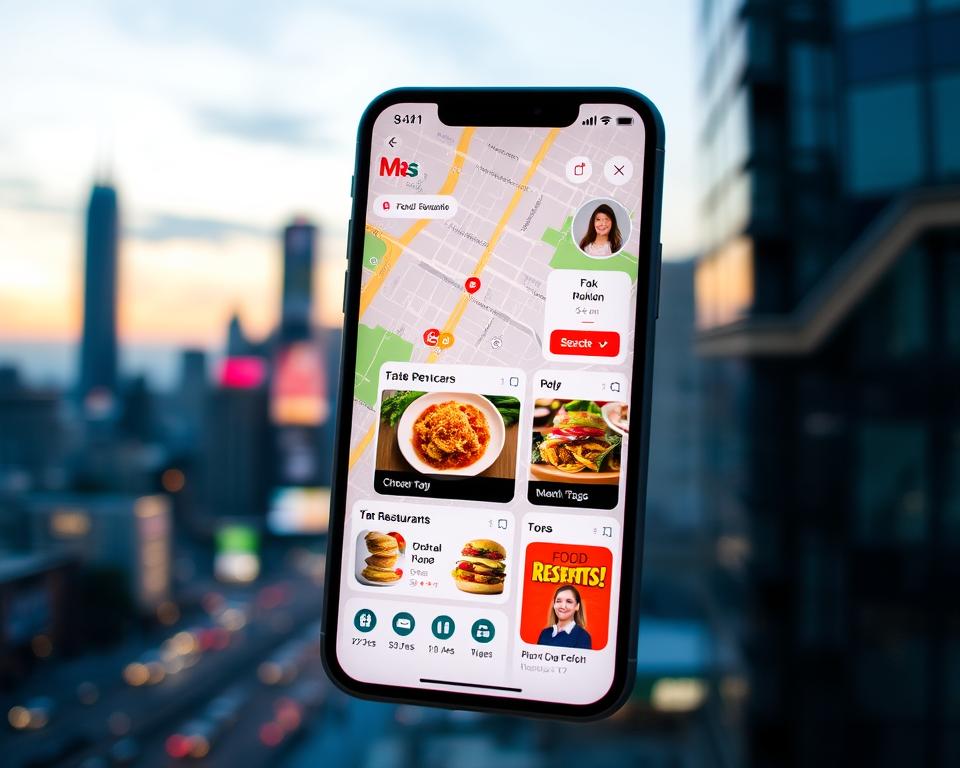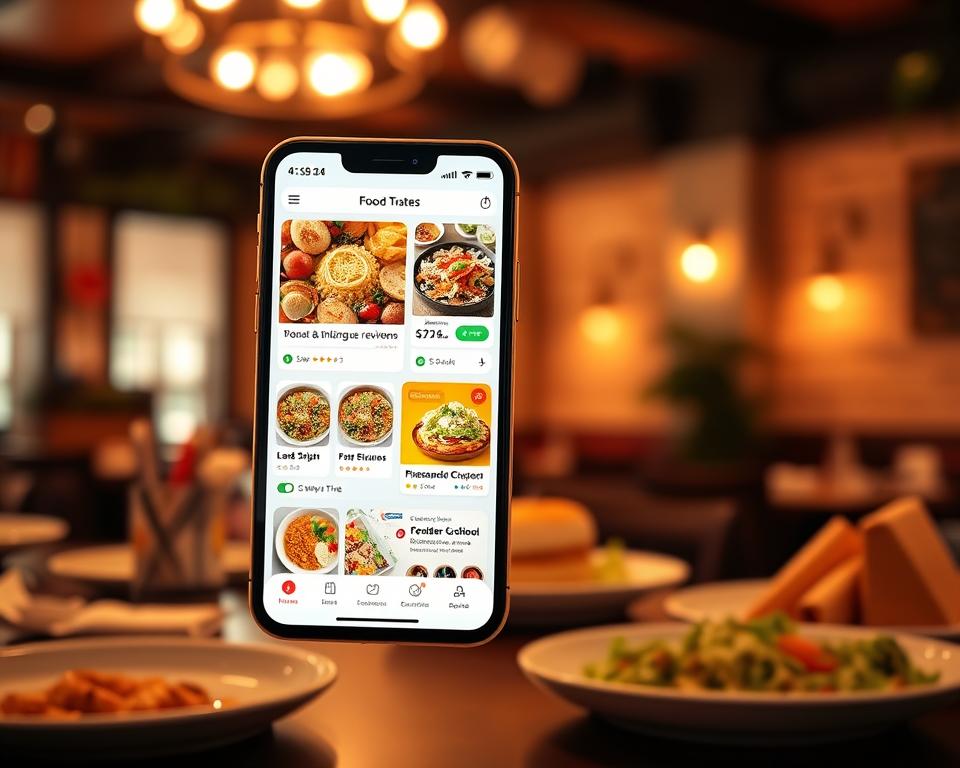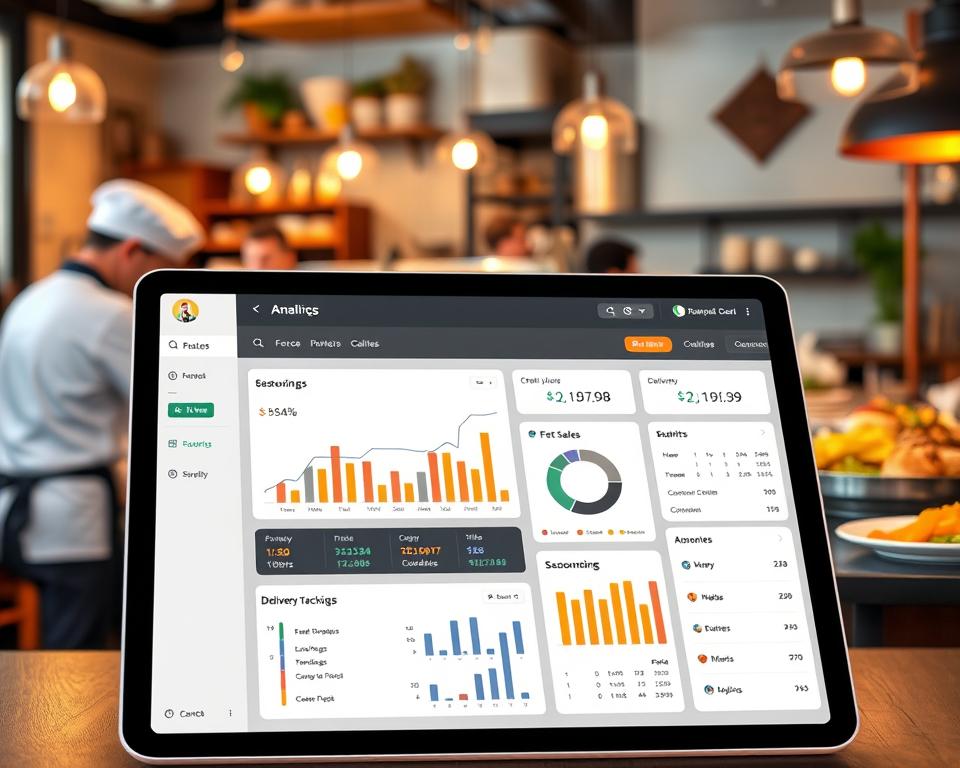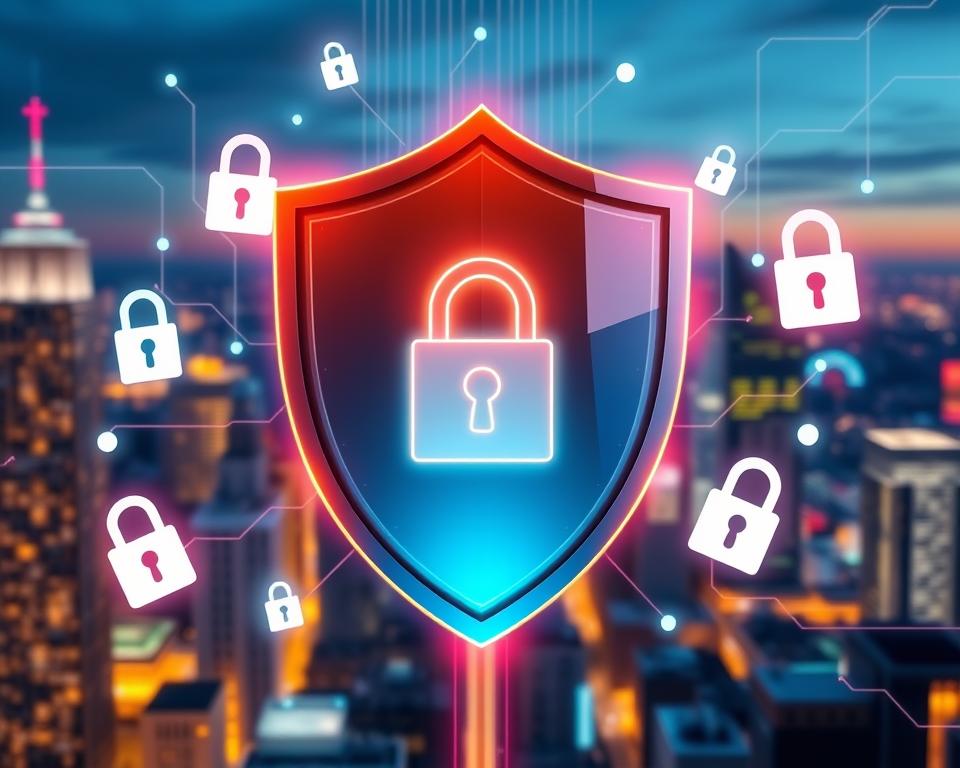The demand for on-demand food delivery has skyrocketed in today’s fast world. DoorDash has become a big name, changing how we get our favorite meals. Now, entrepreneurs and businesses want to make their own food delivery apps like DoorDash.
This guide will show you how to make a food delivery app like DoorDash. We’ll cover everything from understanding the market to adding the latest features and tech. You’ll get useful tips and insights to make your app a reality.
Table of Contents
Key Takeaways
- Analyze the food delivery market to identify key players, growth opportunities, and potential challenges.
- Develop a feature-rich application that caters to the needs of customers, restaurants, and delivery drivers.
- Leverage the right technology stack, including frontend, backend, and database solutions, to ensure a robust and scalable platform.
- Prioritize user experience and interface design to create a seamless and intuitive app for all users.
- Implement real-time order tracking, payment gateway integration, and security measures to enhance the overall user experience.
Understanding the Food Delivery App Market Landscape
The food delivery app industry has grown a lot in recent years. It’s now a fast-changing market. Consumers want convenience, making it a key area for companies like DoorDash, Uber Eats, and Grubhub.
Current Market Size and Growth Projections
The global food delivery app market shows great potential. It’s expected to hit $200 billion by 2025. This growth is over 11% from 2020 to 2025. It shows how much people want food delivered quickly and easily.
Key Players Analysis
A few big players lead the food delivery app market. DoorDash is the leader, thanks to its many restaurant partners and efficient delivery. Uber Eats is strong because of the Uber brand’s global reach. Grubhub is a big name in the US.
Market Opportunities and Challenges
The food delivery app market is full of chances and challenges. It’s growing because more people want things delivered quickly. But, there’s a lot of competition, rules to follow, and keeping delivery efficient is hard.
| Key Players | Market Share | Competitive Advantages |
|---|---|---|
| DoorDash | 55% | Extensive restaurant partnerships, efficient logistics |
| Uber Eats | 25% | Global reach of the Uber brand, technology-driven optimization |
| Grubhub | 15% | Pioneer in the industry, strong brand recognition |
“The food delivery app industry is a rapidly evolving landscape, with fierce competition and immense growth potential. Navigating this dynamic market requires a deep understanding of consumer trends, technological innovation, and strategic positioning.”
Essential Features of a DoorDash-like Food Delivery App
To make a food delivery app like DoorDash, focus on user experience. A good app should let users easily find restaurants, place orders, and track their food in real-time. Here are the key features for a DoorDash-like app:
- User Registration and Account Management: Make signing up easy and secure. Users should be able to manage their account, payment info, and order history.
- Restaurant Discovery and Menu Browsing: The app should have an easy-to-use interface. Users can find and explore restaurants, menus, and get detailed info about each place.
- Seamless Order Placement: The app should make ordering simple. Users can customize their orders, choose delivery or pickup, and pay securely.
- Real-time Order Tracking: Give users live updates on their order. From when they place it to when it arrives, it builds trust and satisfaction.
- Secure Payment Gateway: Use a reliable payment system that supports many payment methods. This makes transactions smooth and safe for users.
With these features, a food delivery app can offer a great user experience. This can lead to loyal customers and more engagement. Focus on design and innovation to stand out in the market.
| Feature | Description | Benefit |
|---|---|---|
| User Registration | Secure account creation and profile management | Enables personalized experiences and order history |
| Restaurant Discovery | Intuitive browsing and menu exploration | Helps users discover new dining options |
| Order Placement | Customizable orders and delivery/pickup options | Streamlines the ordering process |
| Order Tracking | Real-time updates on order status | Enhances customer satisfaction and trust |
| Secure Payment | Reliable and secure payment gateway | Ensures a seamless and trustworthy transaction experience |
“Delivering a stellar user experience is paramount in the highly competitive food delivery market. By focusing on these core features, you can create an app that truly delights your customers.”
Technical Stack Requirements for Food Delivery App Development
Creating a successful food delivery app like DoorDash needs a strong technical stack. This includes the frontend, backend, and database solutions. Each part is vital for a smooth user experience. Let’s look at the key technologies and frameworks for a food delivery app.
Frontend Technologies
The frontend is where users interact most. It must be easy to use, fast, and look good. Mobile app frameworks like React Native and Flutter are popular. They allow for cross-platform development and have many tools and libraries.
Backend Infrastructure
The backend handles the app’s complex tasks. It processes orders, manages user data, and connects with other services. Node.js, Python, and Ruby on Rails are top choices for scalable backend solutions.
Database Solutions
Managing user and order data is key. A mix of relational and NoSQL databases can be used. This combination helps create a strong and flexible data system.
Choosing the right software stack and frameworks is crucial. This way, developers can make a scalable and user-friendly app.
User Interface and Experience Design Principles
Creating a great mobile app experience is key in the food delivery market. It’s all about making the app easy to use and look good. The design of the user interface (UI) and user experience (UX) sets your app apart and keeps users coming back.
The core of a good UI/UX design for a food delivery app is simplicity. The app should be clean and easy to navigate. Users should be able to find restaurants, order food, and track their orders without hassle. With mobile app design, you can make the app flow smoothly, meeting users’ needs without any trouble.
It’s also vital to have a user-friendly interface that works the same on all devices. Whether on a phone or tablet, the app should look and feel the same. This ensures a smooth experience for users, no matter where they are.
| Design Principle | Explanation |
|---|---|
| Simplicity | Streamline the interface, minimize clutter, and focus on essential features. |
| Consistency | Maintain a cohesive look and feel across all platforms and touchpoints. |
| Responsiveness | Ensure the app adapts to different screen sizes and device orientations. |
| Intuitive Navigation | Guide users effortlessly through the app with clear and logical navigation. |
| Visual Hierarchy | Prioritize and highlight the most important information and actions. |
By following these UI/UX design principles, you can make a mobile app that’s not just pretty but also great to use. This leads to happy customers and loyalty in the competitive food delivery market.
“The best design is invisible. It’s only when something is broken that we notice design.” – Don Norman, Cognitive Scientist and User Experience Architect
Building the Customer-Side Application
Creating a strong customer app is key for a food delivery app like DoorDash. This part will look at the main features and functions needed. These are to make the app engaging and easy to use.
Registration and Authentication
It’s important to make signing up and logging in easy for users. Use secure user registration methods like email, social media, or phone number. This makes signing up smooth and easy.
Also, add authentication steps like passwords, two-factor authentication, or biometrics. This keeps customer accounts safe and private.
Restaurant Discovery Features
It’s vital to have a good restaurant search feature. Let users explore a wide range of restaurants. They can filter by cuisine, dietary needs, ratings, or how close it is.
Show detailed info about each place. This includes menus, photos, and reviews from other customers.
Order Placement System
Make the order placement system easy to use. Let users pick their favorite restaurant, customize their meal, and place their order. Add features like tracking orders in real-time and estimated delivery times.
Also, let users leave special instructions or notes for the restaurant and driver.
| Feature | Description |
|---|---|
| User Registration | Secure sign-up options, such as email, social media, or phone number-based registration. |
| Authentication | Password-based login, two-factor authentication, or biometric verification. |
| Restaurant Search | Comprehensive search functionality with filters for cuisine, dietary preferences, ratings, and proximity. |
| Order Placement | Intuitive order placement process, real-time order tracking, and delivery time estimates. |
“The customer-facing application is the gateway to a seamless food delivery experience, and its design and functionality can make or break the overall user satisfaction.”
Developing the Restaurant Partner Portal
The restaurant partner portal is key for a food delivery app’s success. It helps local eateries manage their work well. This portal is where restaurants can handle their menus, orders, and check how they’re doing. It makes working with the delivery platform easier.
Comprehensive Menu Management
The portal should be easy for restaurants to use for menu management. They can add, change, or remove items. They can also post pictures, descriptions, and prices. Good menu tools help restaurants look good online and make customers happy.
Streamlined Order Processing
Order processing is a big part of the portal. Restaurants can see and manage orders as they come in. They can track orders, talk to drivers, and update customers. This keeps things running smoothly.
Insightful Performance Analytics
The portal should also have performance analytics. It shows data on orders, customer feedback, and more. Restaurants can use this info to get better and serve customers better.
With a strong restaurant partner portal, food delivery apps can help local restaurants succeed. This makes sure customers and restaurants are both happy.
Creating the Delivery Driver Application
In the world of food delivery, the driver app is key for efficient and timely service. A strong delivery driver app is vital for services like DoorDash. It gives drivers the tools they need to navigate, manage orders, and optimize routes.
Real-time Location Tracking
The heart of the app is real-time location tracking. This feature lets the app watch the driver’s location and share updates with customers and restaurants. With GPS, the app can give accurate delivery times. This helps customers plan meals and restaurants manage orders.
Order Management Interface
The app must have a simple order management interface. It should let drivers easily see, accept, and track orders. Drivers need access to order details, delivery instructions, and customer info to deliver efficiently.
Route Optimization Features
The app should also have route optimization features. It analyzes traffic, road conditions, and order locations to suggest the best routes. This cuts down delivery times, saves fuel, and is better for the environment.
| Feature | Description | Benefits |
|---|---|---|
| Real-time Location Tracking | Utilizes GPS to monitor the driver’s location and provide updates to customers and restaurants | Improves delivery time estimates, enhances customer experience, and helps manage order queues |
| Order Management Interface | Provides drivers with a user-friendly platform to view, accept, and track the status of assigned orders | Ensures drivers have all the necessary information to deliver orders efficiently |
| Route Optimization | Analyzes traffic, road conditions, and order locations to suggest the most efficient delivery routes | Reduces delivery times, minimizes fuel consumption, and promotes sustainable practices |
By adding these features to the driver app, food delivery services can make deliveries seamless and efficient. This leads to happier customers and more business growth.
Payment Gateway Integration and Security Measures
In the fast-paced world of food delivery apps, keeping payments safe and reliable is key. Users share their financial details with these apps, making strong payment processing systems essential for success.
Food delivery apps must focus on data security to protect customer info and transactions. They use SSL/TLS encryption to keep data safe during transfer. Also, fraud detection tools help spot and stop fraud prevention threats, making payments smooth and secure.
- Integrate secure payment gateways, such as Stripe, PayPal, or Braintree, to facilitate smooth and reliable transactions.
- Implement end-to-end encryption to protect customer data, including credit card information, throughout the payment process.
- Leverage advanced fraud detection tools to identify and prevent fraudulent activities, ensuring the integrity of financial transactions.
By focusing on payment processing, data security, and fraud prevention, app developers can create a trusted platform. This builds confidence in users and keeps them coming back.
“Robust payment security is the foundation of a successful food delivery app. Prioritize it from the outset to earn users’ trust and maintain their loyalty.”
How to Build a Food Delivery App Like DoorDash: Development Tips
To create a food delivery app like DoorDash, you need a solid plan. This includes managing the project well and ensuring quality. Every step, from planning to testing, is key for a smooth app.
Project Planning Phase
Starting with a good plan is essential. You must set clear goals, know your audience, and research the market. A detailed plan with milestones helps keep you on track.
Development Roadmap
A detailed roadmap is vital for your app’s success. It covers all stages, from coding to launch. Using agile methods ensures teamwork and timely completion.
Testing Strategies
Testing is crucial for app quality. Use various tests to find and fix problems early. Regular checks keep the app reliable and user-friendly.
By focusing on the app development process, project management, and quality assurance, you can make a standout app. It will offer a great experience to your users.
“Successful app development is not just about coding; it’s about meticulously planning, managing, and testing every step of the process.”
Implementing Real-time Order Tracking System
To make a food delivery app like DoorDash successful, you need a strong real-time order tracking system. This system keeps customers updated and engaged from start to finish. It uses GPS tracking, real-time updates, and order status notifications to offer a smooth and clear experience.
At the heart of this system is GPS. It tracks the delivery driver’s location, letting customers see their order’s progress. This makes the experience better for the customer and helps manage their expectations.
Your app should also send push notifications for real-time updates. These can tell customers about their order’s status, from when it’s placed to when it’s delivered. Keeping them informed builds trust and confidence in your service.
A detailed order status notification system is key for a great food delivery experience. Customers should get updates on their order’s status, like when it’s being made and when it arrives. This clear communication helps manage expectations and makes your brand reliable.
| Feature | Description | Benefits |
|---|---|---|
| GPS Tracking | Real-time monitoring of delivery driver’s location | Enhances customer experience, manages expectations, and reduces anxiety |
| Real-time Updates | Push notifications for order status changes | Builds trust and confidence in the service |
| Order Status Notifications | Comprehensive information on order progress | Manages customer expectations and fosters reliability in the brand |
With a solid real-time order tracking system, your food delivery app can reach the top like DoorDash. It ensures a smooth and clear experience for your customers.
Scalability and Performance Optimization Strategies
As a food delivery app like DoorDash grows, it’s key to focus on scalability and performance. This means using smart load balancing, database tweaks, and caching. These strategies help the app handle more users smoothly.
Load Balancing Solutions
To keep the app running well, load balancing is vital. It spreads the workload across many servers. This way, no server gets too busy.
Using horizontal scaling and content delivery networks (CDNs) helps the app grow easily. It can handle more users without slowing down.
Database Optimization
The app’s database is crucial for storing user and order data. Database optimization makes the app faster and more scalable. It does this by improving database operations.
By making the database work better, the app can handle more data quickly. This means faster responses for users.
Caching Mechanisms
Caching mechanisms are key for better performance. They store data in memory for quick access. This reduces server load and speeds up user actions.
Using in-memory caching and content delivery networks (CDNs) boosts the app’s speed. It makes the app more responsive and enjoyable for users.
By using these strategies, food delivery apps like DoorDash can offer a smooth experience. This is true even as they grow and handle more data.
Monetization Strategies and Revenue Models
In the world of food delivery apps like DoorDash, making money and growing the business is key. The industry has seen huge growth. But, app developers must pick the right strategies to keep their platform profitable.
One main way apps make money is through commission fees. App monetization through these fees means charging restaurants a part of each order. This way, the app, restaurants, and customers all benefit from the service.
Another way is by adding delivery charges. Revenue generation can be boosted by a fee for each delivery. This helps cover the costs of logistics and operations. It also encourages customers to use the app’s services.
Also, business model diversification can come from ads and premium features. Apps can earn more by offering ad space to local businesses. They can also provide premium plans with special discounts or fast delivery.
By trying out these app monetization, revenue generation, and business model strategies, developers can make a successful and profitable app. This benefits everyone involved.
Conclusion
Creating a food delivery app like DoorDash is a big task. It involves understanding the market, adding key features, and using the latest tech. The food delivery market is growing fast, offering many chances for success.
Those wanting to start a food delivery app face big challenges. They must deal with tough competition, changing tastes, and making sure everything works smoothly. By planning well, focusing on user needs, and thinking about growth and making money, they can do well.
The secret to success in food delivery apps is to be innovative and flexible. By using food delivery app development, entrepreneurs can find new market entry chances. They can succeed in the fast-changing entrepreneurship world.








